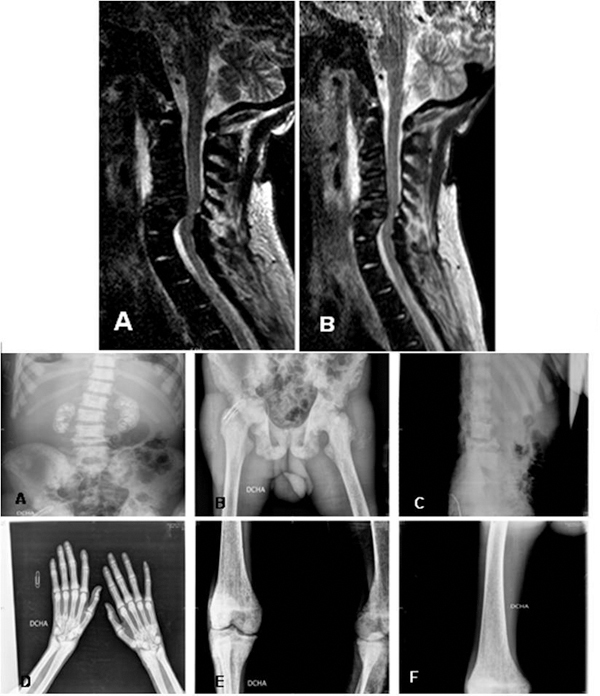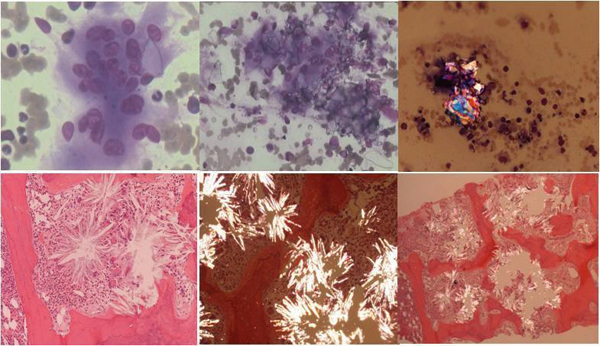To the Editor,
Primary hyperoxaluria (PHO) is a fairly rare metabolic alteration. Its annual incidence is 0.11-0.26/100 000 births and its prevalence is 1-2.9/1000 000 inhabitants, approximately.1 In Spain, there is a relatively high number of cases, given its increased incidence on the Canary Islands (especially La Gomera).2 Diagnosis is usually delayed: with an average interval of 3.4 years between the onset of the symptoms and its diagnosis. Only 30% of cases are diagnosed early.3 As such, in most cases, patients present with oxalate deposits in the definitive diagnosis, even in the cardiovascular system, which inevitably leads to death. PHO is caused by an enzymatic defect located in the hepatocyte peroxisome, which enhances glyoxylate conversion to poorly soluble oxalate.4 The AGXT gene is affected in primary hyperoxaluria type I, which is found in the chromosome 2q36-37. It corresponds with the alanine-glyoxylate aminotransferase enzyme (43kDa protein)2, which needs vitamin B6 (pyridoxine) to function correctly. Various mutations in the AGXT gene have been observed, involving multiple defects, among which the most frequent is the lack of immunoreactive and catalytic activity (42%).5 The only treatment performed successfully in these patients is liver or liver and kidney transplant, which may supplement enzymatic activity and kidney function, respectively.
We present the case of a 24-year-old Maghreb man, with a history of chronic renal failure (CRF) secondary to nephrocalcinosis. He presented with several infections, two abscesses in the right psoas muscle and the left sternoclavicular joint, although the aetiological origin could not be identified in either of the two cases. In the same year he had a thalamic stroke and right perimesencephalic haemorrhage. He was admitted to his area hospital with severely deteriorated condition, with recurrent fever and episodes of arthritis in his right shoulder due to S. epidermis and in his left sternoclavicular joint due to enterococcus. Both were secondary to permanent catheter-related bacteraemia in the right jugular vein (he previously presented with thrombosis in several vascular accesses). During hospital stay (which lasted a year) numerous complications occurred: chronic severe anaemia, upper digestive haemorrhage, uraemic pericarditis, and pneumonia with pleural effusion. In the last few weeks of the hospital stay, he had left-side neck pains, significantly limited functions, fasciculations, fever, and negative blood culture tests. Magnetic resonance imaging (Figure 1) was performed. Secondary spondylodiscitis was suspected and the patient was referred to our health centre for a decompressive laminectomy.
During the physical examination upon arrival, we found deterioration of his general condition, cachexia with muscular atrophy (which prevented him from walking), hypotension, tachycardia and fever. He had a normal heart rate and a pansystolic murmur with hypoventilation of the lung bases. He had painless hepatosplenomegaly. Both knees were swollen and the right shoulder was visibly swollen.
Anaemia was discovered in the laboratory tests (Hb: 8.3g/dl), leukocytosis: 18 900, parathyroid hormone (PTH): 83pg/ml and changes to inflammatory and nutritional parameters (GGT: 544IU/l; albumin: 0.7g/dl and ferritin: 5.93ng/ml PCR). A bone scan was performed, which showed signs of advanced secondary hyperthyroidism. The main alterations can be seen in Figure 1. The cervical CT revealed a significant kyphosis at the C5-C6 vertebral body height, alteration in their morphology and a severe reduction in the antero-posterior diameter, which significantly compressed the medulla at that point and caused foraminal stenosis.
A biopsy and a bone marrow aspiration were performed which found multinucleated giant cells derived from monocyte macrophages containing oxalate crystals birefringent to polarised light. In the bone marrow the medullar space had been substituted by concentrically disposed crystals, grouped together in a star or rosette shape, which were refringent to polarised light, with peripheral reaction of giant cells and trabecular bone destruction (Figure 2). With these findings the patient was diagnosed with primary hyperoxaluria. Palliative treatment with vitamin B and intensive dialysis was indicated, but the patient died 30 days after hospitalisation.
This case illustrates the harmful consequences associated with the delayed diagnosis of this rare disease, which is fatal if aggressive treatment is not indicated early. Current therapeutic alternatives for patients with CRF are palliative (kidney transplant) or curative, although they have a high morbidity rate (liver and kidney transplant).2
In 1997, Hoppe found a very low PHO frequency in the dialysis population. He observed delayed diagnosis in 42% of the patients and 30% were diagnosed when they already had end-stage kidney disease.3
The most common and earliest manifestations of the disease are nephrocalcinosis (due to oxalate crystals forming in the kidney parenchyma) and urolithiasis (being excreted through the pyelocaliceal system). Manifestations vary depending on the patient’s age. In small children, it is characterised by CRF with massive parenchymal oxalosis. Older children present with symptoms of urolithiasis and in some cases, complete obstruction with acute renal failure. It often occurs with end-stage kidney disease in adult patients.6 Unfortunately, PHO diagnosis was delayed for our patient, leading to his death.
A simple method for detecting this disease can be measuring urinary oxalate excretion. In normal conditions, excretion is 0.5mmol/1.73m2/day or 45mg/1.73m2/day. People with PHO have a significant increase in urinary oxalate excretion (>1mmol/1.73m2/day or 90mg/1.73m2/day).6 This excretion rate is less useful for kidney failure patients, as in our case, given that the patient already had advanced CRF. In these cases, the increase in plasma oxalate would help to reach a diagnosis, alongside calcium oxalate in tissues,7 although not all laboratories have this possibility. A liver biopsy is the only test which confirms definitive diagnosis of PHO. Depending on the laboratory, it can provide information on whether there is immunoreactive protein or not (Western blot), subcellular localisation (IF) and even the type of mutation (sequencing).9
In our case, diagnosis was performed by biopsy and bone marrow aspiration. As a general rule, oxalate deposits appear in end-stage kidney failure, developing more quickly during chronic haemodialysis. These oxalate deposits with surrounding reaction provoke lesions similar to secondary hyperparathyroidism lesions8 and severe anaemia resistant to erythropoietin (EPO), as has been described previously.10
Lastly, we must stress the importance of detecting this disease early, given that the effectiveness of treatment depends on how quickly it is diagnosed. A delayed diagnosis leads to CRF and massive oxalate deposits in organs and tissues. This must be considered for the population at risk: i.e. people from the Canary Islands and Maghrebians. The Canarian population with PHO are not Maghreb but Caucasian, but given that it is an island, a cross over has occurred.
Figure 1.
Figure 2.










